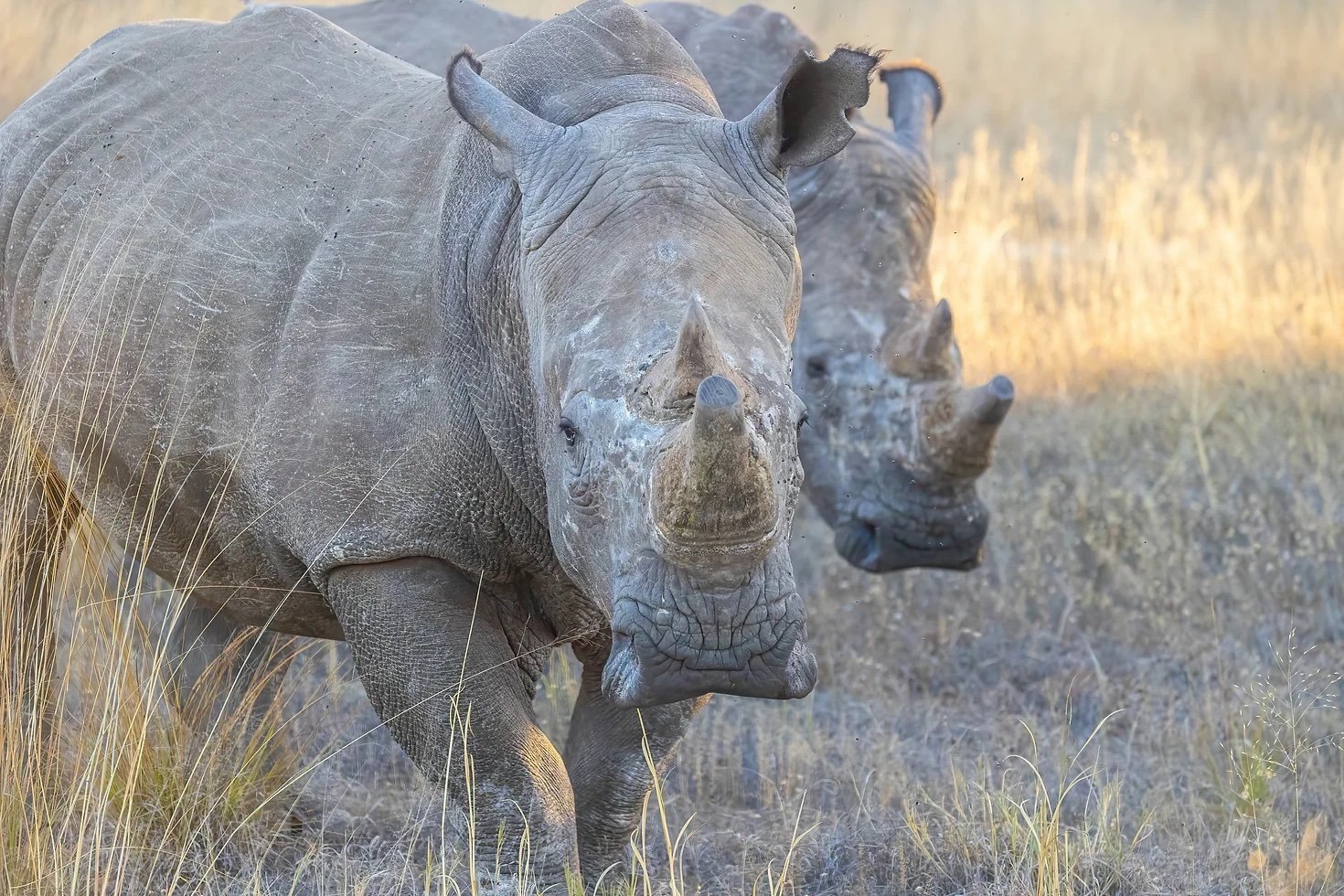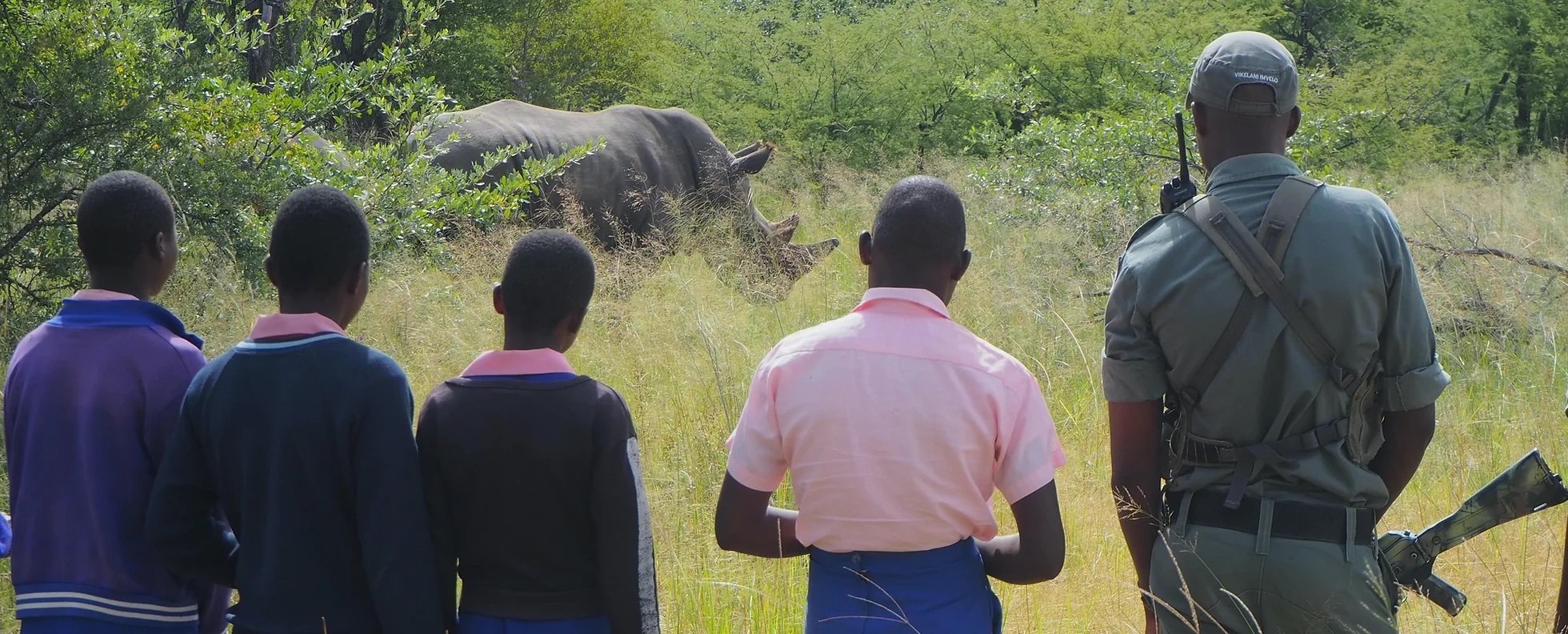
COMMUNITY RHINO CONSERVATION INITIATIVE
Community Rhino Conservation Initiative:
A Model for Community-Based Conservation & Development
Location: Hwange National Park, Zimbabwe
Grantee: Community Rhino Conservation Initiative | Water4Wildlife Trust
Nominated by: Wilderness Travel & Mountain Travel Sobek
Year: 2023
Grant: $15,000
Goal
CRCI is a ground-breaking collaborative project that has brought white rhinos to communal lands adjacent to Zimbabwe’s Hwange National Park, in an effort to (1) rebuild viable populations of white rhinos in the area, (2) establish a buffer zone between the National Park and communities to alleviate human-wildlife conflicts and (3) provide socio-economic opportunities for the communities who are custodians of these rhino (through employment, education and school children visits, engagement and tourism revenue from rhino viewing fees).
Project Summary
CRCI can best be described as a phased program to evolve naturally with local community engagement. Phase 1 (The pilot project) consists of an intensively protected sanctuary at Ngamo with 2 white rhinos, protected 24/7 by armed scouts. Forty percent of the fees paid by tourists go to the communities, for them to allocate to a socio-economic development project of their choice. The communities decided to use the funds to maintain the donor-funded Ngamo Clinic operational, with these funds paying for nurses’ salaries and food, as well as drugs, medications, and other expenses.
Phase I has encouraged more communities to want to allocate some land to rhino conservation. CRCI is currently fencing an area amalgamating land from three different communities wanting to be part of CRCI and establishing sanctuary 2 as a result of the success of Phase I. Phase II involves the establishment of a series of intensively protected community-based sanctuaries along the Park boundary on communal land, evolving naturally with community engagement. A second sanctuary area was agreed and fencing is currently being carried out but further support from ATCF is needed for infrastructure, scout recruitment and training, equipment and uniforms, empowering local people to be directly involved in conservation.
Phase III will represent a large protected area that will consolidate community sanctuaries into a conservancy as a large buffer zone between the Park and communal lands and accommodate a viable population of free-roaming white rhinos to benefit local people.
How will this project support the community, culture, and landscape?
CRCI brings employment and education opportunities as well as funds for socio-economic development, including water wells and irrigated fenced gardens; these allow for more productive land and optimized use of land resources benefiting the landscape as a whole. CRCI directly safeguards communal grazing land from wildlife by being on the boundary of the Park and by therefore fencing off a physical buffer zone to alleviate conflicts. This facilitates the restoration of communal lands to productive subsistence farming lands while also expanding wildlife (rhino) territory.
CRCI allows international and national tourists greater access to local culture and wildlife and attracts more visitors to the area. It facilitates an improved social connection, exchange, and sharing of cultures between international visitors and local communities and helps open minds on both sides by providing new educational experiences for visitors and new outlooks for local people. It also allows for more philanthropic opportunities. CRCI has already had community members and over 750 school children and teachers visit its first sanctuary. Children hear and meet the scouts in charge of protecting the rhino, find out about rhinos and other animals, do drawing and drill activities, and walk with the rhino and scouts. This helps inspire young people and educate them not only about rhino but about wildlife generally. A better understanding of what the benefits of wildlife are, and can be, especially among children is important to instilling and sustaining a long-term appreciation for conservation and reversing negative attitudes towards wildlife (born out of human-wildlife conflicts).
An early risk assessment highlighted risks including those of losing rhinos to poaching (hence the phased and slow approach to reintroducing a viable population as well as the emphasis on scout training and rhino protection) and not being able (because of a lack of funds) to keep up with community appetite to engage in the project. However, the benefits generated by CRCI so far (within one year) are so significant that any risks taken have already been justified.
What are the impacts you hope to see as a result of this project?
A slow and steady reintroduction of rhinos to the Hwange ecosystem, building a viable population
Improved livelihoods and well-being for communities living along Hwange’s boundary
Alleviated human-wildlife tensions through the establishment of a physical buffer zone
Greater awareness among tourists of the difficulties of living with wildlife and the importance of conserving both environmental and cultural integrities of wildlife areas
How will this project combat climate change?
CRCI is repurposing low-productivity grazing land for wildlife conservation and providing a wildlife buffer zone for villages. The repurposed land is safeguarded from illegal poaching and logging, allowing for better carbon storage, and communal lands are protected from elephants destroying trees and vegetation – thereby maintaining resilient ecosystems.
CRCI’s primary drive has been biodiversity (rhino) protection, with wildlife/habitats holistically benefitting as the rhino represents a catalyst for conservation in general. CRCI’s byproducts have included habitat conservation (by properly fencing off areas for wildlife) as well as landscape productivity. Funding generated by CRCI could be used, if chosen as such by the community, to improve land productivity in the villages through irrigation and agriculture projects. This will help optimize the amount of land needed for agriculture and allow for improved land and habitat preservation for greater climate resilience.
What does final success look like?
A viable rhino population returned to the Hwange ecosystem, on communal lands, with the local communities benefiting in the form of employment, development projects, education, and tourism interactions.
Get to know the Hwange community
What makes this community unique?
The isolated and impoverished villages along the Park’s southern boundary rely on subsistence farming and livestock husbandry in an area of low soil fertility, regular droughts, and human-wildlife conflicts. The area also has very few income opportunities thereby naturally generating negative local attitudes towards wildlife. However, communities closest to Imvelo Safari Lodges have developed a unique perspective...that visiting tourists, coming to see wildlife, bring many benefits and so local wildlife is something to be celebrated. Many members of the communities closest to these tourism lodges work in hospitality, as wildlife guides, or as trained community wildlife protection scouts. Tourists also visit their villages, buy locally hand-made crafts from their relatives, encourage their children to practice English at the local schools, or even donate to community development projects. Community members understand that the burdens of wildlife can be alleviated by the benefits of tourism. This has been evidenced by a small herd of wildebeest that was seen on one of the village lands a few years ago; its size has more than tripled in the last five years proving that the local people are not poaching the wildebeest, but helping to grow the population. The community has understood the value of bringing back rhinos to the area and has, in a pioneering move, allocated some of their grazing land for wildlife, specifically for rhinos. With CRCI’s Phase I pilot project proving successful, more communities along the Hwange Park boundary want to follow this community’s unique approach to wildlife conservation.
Conservation challenges
Rural communities living along Zimbabwe’s Hwange National Park southern boundary suffer from acute food shortages, a lack of socio-economic opportunities, impacts of the national economic crisis, devastating effects of prolonged droughts, isolation from social services, limited access to surface water...such hardship is compounded by significant human-wildlife conflicts with elephants and predators regularly overspilling into their communal lands. Levels of poverty are high and livelihoods are vulnerable. Over the last 20 years, as a result of CAMPFIRE (Communal Areas Management Program for Indigenous Resources) and the ripple effects of tourism as well as philanthropy, the area has seen considerable social, economic, and infrastructural developments: classrooms and clinics have been built, water wells have been drilled and maintained, food has been provided, etc. While efforts in the area to promote wildlife conservation and sustainable natural resource use have been successful and poaching has been limited, the disappearance of the white rhino from the Hwange ecosystem in the early 2000s, following the devastating “rhino wars,” has not gone unnoticed.
Does Hwange rely on a protected area to attract visitors?
The community relies on Hwange National Park, which attracts travelers from around the world for community development, employment, and revenue opportunities. The community has also been at the heart of founding CRCI, which, although on communal land, is now a protected area that is attracting travelers wanting to see rhinos while also contributing to rhino conservation and local community development. Forty percent of tourist rhino viewing fees go straight to the communities for them to allocate to a development project of their choice; the remaining 60% is to maintain the existing operations and expand CRCI into phases 2 and 3 (see question 8).
How will this project support the communities impacted by tourism?
Almost all income generated by CRCI’s rhino tourism fees goes back to the communities in the form of (1) direct revenue currently being used to maintain the local donor-funded Ngamo clinic operational as decided by the local “Rhino Trust”, (2) salaries going back into the communities and (3) expanding the project to employ more people and benefit more communities, while also promoting rhino conservation and creating a fenced buffer zone to reduce human-wildlife conflicts.
Q1 2024 Progress Report Summary
Q2 2024 Progress Report Summary
Donate Today!
This project has already been awarded $15,000 by global businesses in the travel and outdoor industries! Help them achieve even more impact and make a donation today!
More about the Community Rhino Conservation Initiative
In 1985, Hwange National Park had 100 white rhino; by the 1990s, poaching was rampant. In 2007, the last white rhino was seen and killed by foreign poachers near Ngamo in the southern part of the Park. The Community Rhino Conservation Initiative aims to re-introduce rhino to this part of Zimbabwe in a highly secure and sustainable way to eventually accommodate a viable population of free-roaming black and white rhino. It also establishes a buffer zone between the Park and the communal lands, to stop wild animals from being a burden to communities and destroying their crops and domestic livestock.
More about Water4Wildlife Trust
The Water4Wildlife Trust is working with Imvelo Safari Lodges on a variety of community and conservation projects in and around Hwange. It founded the Community Rhino Conservation Initiative - or CRCI - the seeds for which were planted with the first batch of Community Wildlife Protection Scouts being recruited in late 2018. CRCI was officially launched in May 2022 with the first two white rhino arriving at the Ngamo sanctuary on communal lands.









